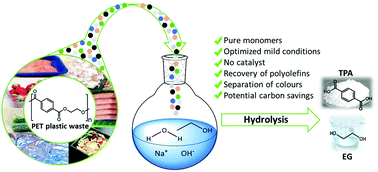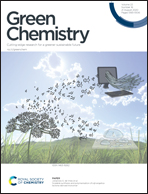Towards closed-loop recycling of multilayer and coloured PET plastic waste by alkaline hydrolysis†
Abstract
The vast increase in the generation of post-consumer PET plastic waste, as well as fast increasing pledges of brand owners around the world to include recycled content have resulted in a pressing need for efficient recycling processes, such as chemical depolymerization. Although recycling rates of PET bottles are high, those of PET trays and films are still significantly lower due to the broad range of colours and multilayer structures, as well as due to a much poorer collection. In this study, a two-step aqueous alkaline hydrolysis was carried out on different types of real PET plastic waste under mild conditions (≤80 °C under atmospheric pressure). Reaction conditions such as temperature (50–80 °C), ethanol to water ratio (20–100 vol%), NaOH amount (5–15 wt%) and stirring rate (250–500 rpm) have been optimized by using pure PET pellets in order to maximize the product yield. At optimal conditions (60 : 40 vol% EtOH : H2O, 5 wt% NaOH and at 80 °C) product yields on a mass basis of approximately 95% have been achieved in less than 20 minutes. The purity of the obtained monomers, ethylene glycol (EG) and terephthalic acid (TPA), was characterized by NMR, UV-VIS and FTIR measurements. The experimental kinetic data are represented adequately using the diffusion model. Experiments performed at optimal conditions with different types of post-consumer plastic waste, revealed that the degradation rate increases inversely proportional to the particle size. Furthermore, the increased thickness of the samples and the presence of multilayers reduce the decomposition yield with a factor two as observed for monolayer (80%) versus multilayer PET trays (45%). In addition to transparent multilayer PET samples, by using the optimized alkaline hydrolysis with further cleaning processes different types of colours, including carbon black are removed from the hydrolysate successfully. A life cycle assessment (LCA) shows that the key to lower the carbon emissions is keeping the energy consumption low by increasing the solid/liquid (S/L) ratio and avoiding excess water addition during monomer purification.



 Please wait while we load your content...
Please wait while we load your content...